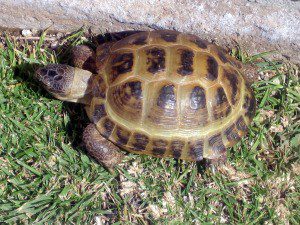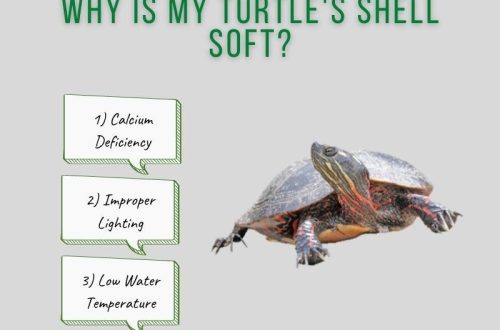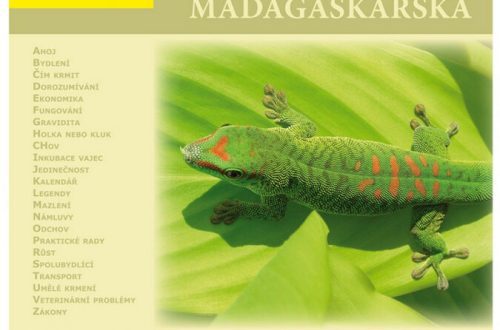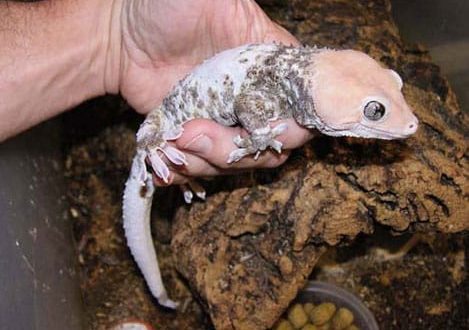
Land Central Asian tortoise, maintenance and care
Many of these turtles lived in childhood, perhaps they still live today. They come to us from the wild and are very demanding on the appropriate conditions of detention. Unfortunately, contrary to myths, such turtles at home rarely live longer than 20-30 years. That is why, in order to make the pet’s life pleasant and healthy, you need to properly equip the terrarium. The turtle should not live on “free pasture” in the apartment, and even more so hibernate near the battery (although this was deposited in the minds of our fellow citizens as their normal and proper behavior).
Female Central Asian tortoises can reach 30cm, so be prepared for a large horizontal terrarium. While the turtle is small, you can start with about a 100 liter terrarium with dimensions of about 60x40x40. As the “apartment” grows, it will have to be changed to a more spacious and high one so that the turtle cannot jump over the walls.
The choice of soil is a very controversial issue. The fact is that due to the lack of minerals and the inconsistency of home conditions with natural ones, these turtles tend to swallow soil and other small objects. Experts are inclined to believe that the best option is large chips, twice the size of a turtle’s head, which a pet cannot swallow, or alfalfa granules, which are absolutely safe when swallowed. Sand, sawdust, pebbles and stones pose dangers and promise problems. The turtle will swallow small stones, which will cause obstruction of the gastrointestinal tract, and large stones will constantly hit. The soil must be poured in a thick layer so that the turtle can dig in it.
Speaking of digging! If you notice that the turtle scratches all day long in the terrarium, then this is absolutely not because she is insanely bored and wants to walk around the apartment. It’s just that in nature they spend their time in this way: they eat, sleep and dig the ground. Moreover, they are not travelers and live in a small but well-explored territory. Therefore, when you release a turtle into a room, it, of course, becomes more active, but only because it has entered a new, alien territory. And she just has to start exploring it. If you release it often, then, in the end, after examining it, it will again hide in a corner and start digging already there. So don’t stress her out, let her live in a safe and familiar terrarium.
In nature, turtles live in warm, sunny conditions, so it will take some work to make the turtle feel at home. It is necessary to organize a warm corner with a temperature of 31-35 degrees and a cool corner where the turtle can hide from overheating – with a temperature of 24-26. In a cool corner, you can put a shelter (half of a clay flower pot is fine). And do not put a fabric bed in the shelter, she will also begin to dig, which can lead to the fact that the threads can wrap around her fingers, or she will swallow them. Both of these can lead to disastrous consequences.
Turtles are very dependent on ultraviolet radiation, the deficiency of which is the cause of many diseases, such as rickets, hypovitaminosis, and decreased activity. The UV lamp must have an intensity of UVB 10.0. As already written in other articles, ultraviolet does not pass through glass, so the lamp must shine directly on the surface. In addition, the intensity of ultraviolet radiation in the lamp gradually decreases, and the lamps must be changed every 6 months. The ultraviolet lamp and the heating lamp should burn all daylight hours – 10-12 hours each. They need to be hung at a distance of about 30 cm from the surface and the turtle so that they do not cause a burn.
In the terrarium, you can make a small and shallow pond (about half the thickness of the shell) with a convenient exit from it. Turtles that get enough water with food may not drink, but almost without exception, they prefer to go to the toilet in the water. If there is no reservoir in the terrarium, then it is advisable to give the turtle warm baths (with a water temperature of 34–36 degrees) every 2–3 days, for 30–60 minutes.
And now about nutrition. The basis of the diet (about 80%) should be leafy greens. These are all kinds of salads, home plants – hibiscus, tradescantia in winter, and dandelions, plantain, clover, thistle, geranium, carrot tops in summer. If you are not sure whether a plant is poisonous to a turtle or not, then it is better to ask a specialist, or simply not give it. You can freeze or dry greens for the winter. It is also useful to put apple, cherry, pear branches in the terrarium. This is an additional source of fiber, in addition, they are hard, which contributes to the grinding of the beak. It is advisable to give vegetables in a limited amount (about 15% of the diet). They can be added as an appetite stimulant, as turtles respond well to bright colors and are attracted to, for example, bright sweet peppers, carrots. It is strictly forbidden to give bread, dairy products, citrus skin, apple seeds, meat, it is also better to minimize the giving of citrus fruits, grapes, cucumbers. Sometimes you can give berries and fruits, but keep in mind that turtles can be picky and, having tried strawberries or raspberries once, refuse to eat greens.
A mandatory requirement is to give vitamin and mineral supplements (from those presented on our market, it is better that they be Reptocal and Reptolaif, mixed 2: 1, which you will give per turtle weight at the rate of 1,5 g of a mixture of supplements per 1 kg of mass per week, along with food).
If in the summer you decide to please the turtle with walks in the fresh air, then remember that their slowness is exaggerated, these animals run fast enough. Of course, you can walk them in warm sunny weather, but under supervision, since in addition to fleeing, there is still a danger of dogs and crows attacking them, for example. If you decide to make her an open-air cage on the street for walking on warm, fine days, then you need to remember some points. The aviary should have a shade or shelter where you can hide from the sun. The height of the enclosure should be such that the turtle does not climb over it, it must also be dug into the ground, 30-40 centimeters, otherwise you will not notice how quickly the turtle will dig and run away. In this they are real experts, rest assured!
Finally, a few words must be said about hibernation. This is the cornerstone in keeping these turtles. It is better that the turtle does not hibernate at home, as hibernation requires preparation, special conditions, and health monitoring. When falling asleep under a battery, turtles do not stop the synthesis of uric acid in the kidneys, which leads to their gradual destruction. Everything can end badly, the turtle may not wake up after another such hibernation.
We will highlight a separate article on the correct organization of hibernation, for those who set out to organize it for their pet. The correct organization of hibernation for land turtles.
If you notice disturbing changes in the condition of the turtle, it is better to consult a specialist, many procedures and preparations used for cats, dogs and people are not only unsuitable, but also dangerous for turtles.
Thus:
- The Central Asian tortoise should not live on the floor, it needs an equipped spacious horizontal terrarium.
- The temperature in a warm corner should be 31-35 degrees, in a cold 24-26.
- Mandatory in the terrarium and an ultraviolet lamp with a level of 10.0 (it should burn 10-12 hours a day)
- In a terrarium, shelter is necessary, but without the use of a cloth bedding.
- As a substrate, it is best to use large chips that the turtle cannot swallow, or safe alfalfa granules.
- Hibernation in unprepared conditions and without health control is harmful and dangerous, you should not allow the turtle to hibernate without preparation.
- A terrarium needs a pond. If there is no reservoir, then it is necessary to regularly arrange warm baths.
- 80% of the diet should be leafy greens, you can also add various fruits and vegetables to it. You can not give bread, dairy products, citrus skin, apple seeds, meat, poisonous plants.
- During life, it is necessary to regularly give vitamin and mineral supplements for reptiles. It is impossible to smear with vitamin preparations the shell and skin of the turtle.
- If in the summer in warm weather you decide to walk the turtle, do not leave your pet on the street unattended.
- Follow the rules of personal hygiene, wash your hands after contact with the turtle and cleaning the terrarium.





